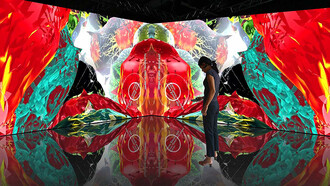Giovanni Bellini (1438–1516) was a renowned 15th-century Venetian painter and was recognized for his harmonious use of color. His paintings featured diverse Renaissance and late Gothic styles. The masterpiece Lamentation over the Dead Christ (1475) is one of the finest works of Italian art, and it demonstrated Bellini's maturity. The work portrays the anointing of Christ’s body before his entombment. The four figures—Christ, Joseph of Arimathea, Nicodemus, and the Magdalene—are depicted.
Un Capolavoro per Milano (A Masterpiece for Milan) initiative provides a large national and worldwide audience with the opportunity to view a timeless piece of art. In its 16th edition this year, Il Museo Diceosano Carlo Maria Martini hosted the exhibition Giovanni Bellini, The Lamentation From The Vatican Museums, in partnership with the Vatican Museums, between February 20th and May 11th, 2024. The masterpiece Lamentation over the Dead Christ (1475) by Giovanni Bellini was displayed. The exhibition is curated by Nadia Righi, director of the museum, and Fabrizio Biferali, curator of the 15th- and 16th-century art department for the Vatican Museums.
After entering the show, there are two lightly painted rooms dedicated to the exhibition’s creation process and information on Bellini’s artistic progress. The informatic dedicated to the Lamentation over the Dead Christ (1475) is quite important regarding the original position of the work. This piece originally topped the Pesaro Altarpiece, a six-meter-high enormous piece, and was meant to be appreciated from a distance. It was painted in Venice around the 1470s. In the central panel, the Coronation of the Virgin between Saint Paul, Saint Peter, Saint Jerome and Saint Francis is depicted, and more saints are visible in the pilasters. The revolutionary aspect of this polyptych is that the “painting inside of a painting” idea in the central piece. A landscape is visible outside the window behind the figures, and there are parallels between the window and the original frame of the piece. The top part, Lamentation over the Dead Christ (1475), was separated from the rest in 1797 and later recovered in 1816 to Pinacoteca Vaticana in 1820.
After understanding the journey of the masterpiece and its original state, a mysterious third room draped in black, opaque curtains greets visitors with a hymn-like original tune by Walter Muto. Upon entering the room, three types of visuals are seen. A slideshow of details of the piece, three hanging model-like frames, and a real-size visual of Pesaro Altarpiece with Lamentation over the Dead Christ (1475) on top are complete. The suggested designed path pulls the visitor to the screen for a closer look at the details. Upon turning back to continue the exhibition, cut-out white frames align perfectly with the real-size Pesaro Altar image. The size and abstractness of the frames point out the genius application of Bellini’s “painting inside of a painting” idea even more. The three cut-out frames and the image of the altar have space in between them, which forces the visitor to observe the image from a distance. This can also be viewed as an homage to the original context and placement of the work, which was intended to be appreciated from afar. After, in a room solely dedicated to the original Lamentation over the Dead Christ (1475) appears. The only lighting in the space is the spotlight on the artwork and a seat for observing it. The journey for the masterpiece concludes with a dramatic ending where all the information and senses received before become a whole.
The exhibition also had a present-day addition as a section called Davanti a Bellini displaying the four contemporary artists: Letia Letzia Cariello, Emma Ciceri, Francesco De Grandi, and Andrea Mastrovito. Being inspired by Bellini’s masterpiece, these four artists produced works that were in dialogue with the original, using different mediums and techniques such as video, painting, and collage. Even if the show includes additional pieces by other artists, curating an exhibition for a single masterpiece is a difficult task. The design of the concept and the space enabled the visitor to comprehend the whole narrative of the master’s creations and the piece. Thanks to the informatics and installation prior to the masterpiece, visitors were able to quickly grasp and visualize the most significant components of the work without having to contemplate. This added to the value of the entire experience and increased the piece’s admirability. As a result, the curation created a space for the visitors to engage with the Lamentation over the Dead Christ (1475) in its complete form.
The opportunity to see Bellini’s masterpiece in Milan was not just a partial encounter. Because of the curation and the exhibition design, the display turned into a multi-layered experience, suggesting that it even forced the visitor to partake in absorbing the creation process of the work. Also, with the addition of the dialogues, the emotions and euphoric sense of the masterpiece prove the effect and relevance of the artist’s masterpiece even today.















